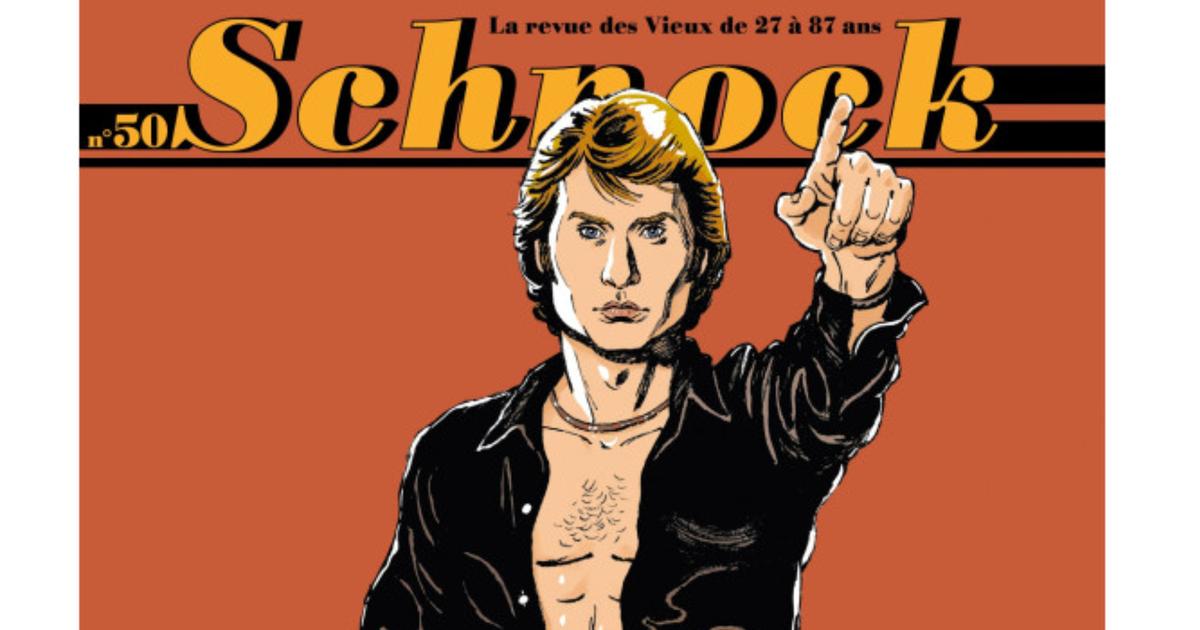Proudly self-proclaimed "magazine for old people aged 27 to 87", the
Schnock
magazine has established itself in the niche of French popular culture from the 1950s to the 1980s,
"against ambient youthism"
, and will release its 50th issue on Wednesday, dedicated to Johnny Hallyday.
Crossing this symbolic milestone,
“it’s a lesson in conservatism
,” laughs its co-founder, Christophe Ernault, 49, also a singer under the pseudonym Alister.
A quarterly magazine that is both vintage and trendy,
Schnock
was born in 2011. Sold for 17.50 euros, it is a “mook” (mixture of magazine and book), a format introduced in France in 2008 by the magazine
XXI.
Over 176 pages, she talks about songs or films from 40, 60 or more years ago, in an erudite and in-depth manner but in a tone full of distanced humor, and with many period photos.
Each issue devotes a long feature to an artist, drawn on the front page on a colored background, which gives the magazine a strong graphic identity.
Also read: Schnock, the art of the alternative route
Jean-Pierre Marielle inaugurated the series, followed by Coluche, Françoise Hardy, Alain Delon, Véronique Sanson and Bourvil.
Schnock
was born from the idea that there was
“a big gap in the cultural press in France”
, says Christophe Ernault.
According to him, this press was
“very limited to a certain type of cultural object, the cinema of the New Wave and its heirs, or somewhat specialized music”
.
The idea was therefore
“to tell the stories of popular stars who perhaps did not have the recognition they deserved”
.
“It’s a retro, vintage and lively look
,” adds the other co-founder, Laurence Rémila, also director of
Technikart magazine.
“Rallying cry”
Mr. Rémila claims the influence of the English cultural press to treat “ objectively light
” subjects
with
“great rigor, great seriousness and a lot of love”
.
A line that the name of the magazine sums up:
“It’s an insult transformed into a rallying cry
,” he smiles.
Schnock
immediately won wide acclaim in the press,
“from Libé to Figaro”
, remembers Mr. Ernault.
Sales followed, in the proportions that are those of a niche media, around 8000 to 9000 copies per issue on average.
Old ones continue to sell well after their publication since some people collect them.
Printed six times since its first publication in 2011, number 1, on Jean-Pierre Marielle, has reached 18,000 sales, a record for the series.
The least well sold is the one on Henri Salvador (5000).
“There is a glass ceiling of about 20,000 people.
There is no point in imagining that we are going to attract 100,000
,” judges Mr. Ernault, who signs numerous articles, the others being written by freelancers.
Alongside the headlines on huge stars, he therefore wants to make headlines about other artists who are a priori less salesy, like Daniel Prévost or Guy Marchand:
“It’s a question of credibility vis-à-vis the real fans of the magazine, those who buy it all the time
.
Also read: Guy Marchand, the most crooning of French actors, is dead
The reader profile?
“People aged 40, 50 or 60, but there are also young people who are rediscovering those years thanks to YouTube,”
replies Alexandre Chabert, from La Tengo, which publishes
Schnock
(with Flammarion as distributor).
According to Mr. Chabert, who does not reveal the budget of the magazine,
“70% of sales are made in bookstores, 20% on newsstands and 10% by subscription”
.
Schnock
only exists in paper version.
“A digital version would not be suited to the content, which is that of a beautiful book more than a magazine
,” argues the publisher.

